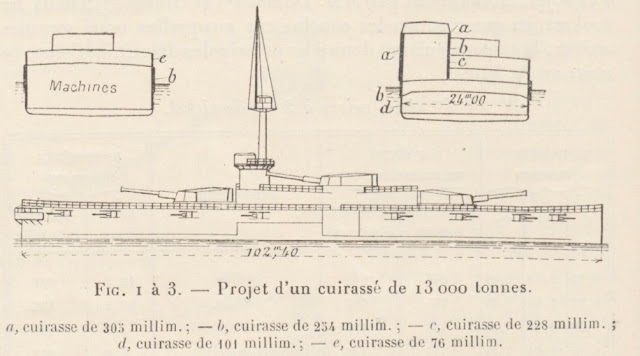On the 5th of June 1914 sir Percy Scott wrote in The Times that battleships had become completely powerless against the submarine. On the 7th to 10th July three naval societies met at Newcastle. The Institution of Naval Architects, the Institution of Engineers and Shipbuilders of Scotland and North-East Coast Institution of Engineers and Shipbuilders.
Here, professor John Biles shared his studies on the underwater protection of battleships. He provided three designs with 100 mm armoured plates below the water line.
 |
| Design 1 (Revista de Marina) |
The first two have the same armament: 6 guns of 356 mm in twin turrets and 16 guns of 152 mm. However, the former has a displacement of 13.000 tons and speed of 10 knots at a length of 102 metres between perpendiculars with a draft of 6 metres. The other design displaced 16.000 tons and had a speed of 18 knots at a length of 132 metres, beam of 24 metres and draft of 7 metres.
The first is in general better protected than the second. 250 mm belt against 125. Upper belt of 75 against 125, turrets of 300 against 125. 56 for both casemates.
The third project is closer to current battleships. Displacement of 28.500 tons, 21 knots speed, armament of 10 guns 356 mm and 16 of 152. Length between perpendiculars of 174 metres, 28 metre beam, 8 metre 70 draft. Armour 250 mm at the belt, 180 and 125 above, 300 turrets, casemates of 50 and deck 75 mm.
In closing he asked the questions:
1: If an armour of 100 mm below the waterline is sufficient against torpedoes in order to adopt on dreadnoughts of the latest type.
2: If the threat of submarines is great enough to warrant the adoption of this armour.
3: If the submarine is a great enough threat to implement this armour and the introduction of slow, small battleships of around 16.000 tons displacement and 6 main guns instead of 8 or 10.
4: If the system of armouring the bottom of ships has enough merit to justify the adoption of a ship form with greater resistance than the ordinary form.
 |
| Design 1 (Le Génie civil) |
Design 1:
Length O.A.: 358 feet
Length P.P.: 336 feet
Maximum Beam: 80 feet
Draft: 20 feet
Displacement: 13.000 tons
Speed: 10 knots
Armaments: 6 of 14 inch, 16 of 5 inch
Belt: 10 inch
Upper belt: 3 inch
Under belt: 4 inch
Casemates: 2 inch
Barbettes: 12 inch
Deck: 2 inch
 |
| Design 2 (Le Génie civil) |
Design 2:
Length O.A.: 460 feet
Length P.P.: 434 feet
Maximum Beam: 80 feet
Draft: 24 feet
Displacement: 16.000 tons
Speed: 18 knots
Armaments: 6 of 14 inch, 16 of 5 inch
Belt: 5 inch
Upper belt: 5 inch
Under belt: 4 inch
Casemates: 2 inch
Barbettes: 5 inch
Deck: 2 inch
 |
| Design 2 (Revista de Marina) |
Design 3:
Length O.A.: 600 feet
Length P.P.: 570 feet
Maximum Beam: 91 feet
Draft: 28 feet 6 inch
Displacement: 28.500 tons
Speed: 21 knots
Armaments: 10 of 14 inch, 16 of 6 inch
Belt: 10 inch
Upper belt: 7 inch
Under belt: 4 inch
Casemates: 2 inch
Barbettes: 12 inch
Deck: 3 inch
Note:
The French article notes a 6-inch secondary battery, whereas the Spanish article notes a 5-inch secondary battery.
Many thanks to Coldown for his contribution. For more of his work, please visit the Spanish blog Reporte de Batalla at:
https://reportedebatalla.wordpress.com/
Sources:
Revista de Marina, 1915, Volume 60 Number 348, pages 31 and further.
Le Génie civil, 34rd Year, Tome 65 Numero 16, page 312 and further. (Number 1679 Saturday 15 August 1914)




No comments:
Post a Comment